AKBU 35 PMQ no longer starts
Question:
My AKBU 35 PMQ suddenly won't start. What could be the reason?
Answer:
Apart from the usual components in question, such as the motor and electronics, a sudden failure of the machine may be due to an incorrectly plugged connection cable. Please check the connection cable.
Media:
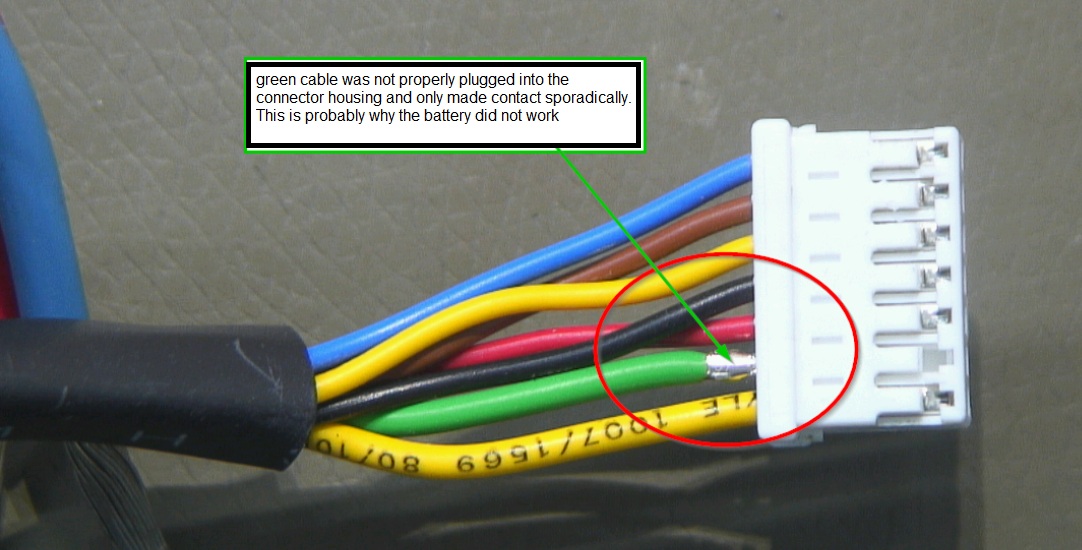
Are FEIN core drills “Made in Germany”?
Question:
Are FEIN core drills “Made in Germany”?Are FEIN core drills “Made in Germany”?
Answer:
The vertical range of manufacture in Germany is approx. 80%.
The majority of our core drilling machines therefore have the label “Made in Germany”.
Individual models are assembled at our site in India.
Are the cork profiles and the holder of the profile sanding set available separately?
Question:
Are the cork profiles and the holder of the profile sanding set available separately?
Answer:
Yes, the profiles and the holder of the profile sanding set are also available separately. You will find the corresponding order number in the attached image file.
You can obtain accessories from one of our specialist dealers in your area. You can find the address on our website under Dealer search.
Media:
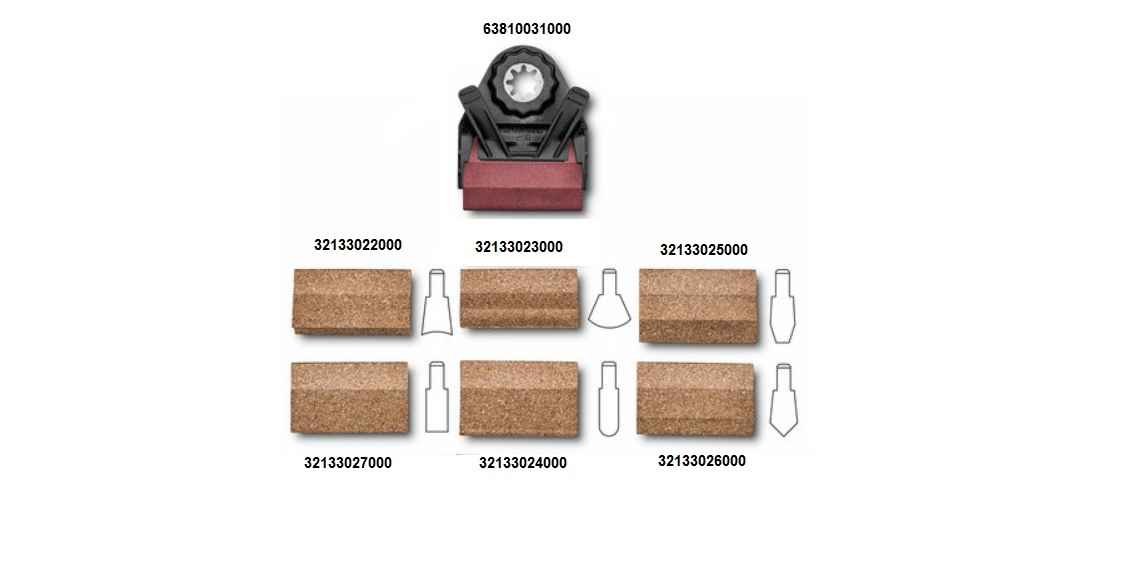
Are there any maintenance or calibration recommendations for AccuTec industrial screwdrivers?
Question:
Are there any maintenance or calibration recommendations for AccuTec industrial screwdrivers?
Answer:
Under Media, you will find maintenance/calibration recommendations for AccuTec industrial screwdrivers.
Media:
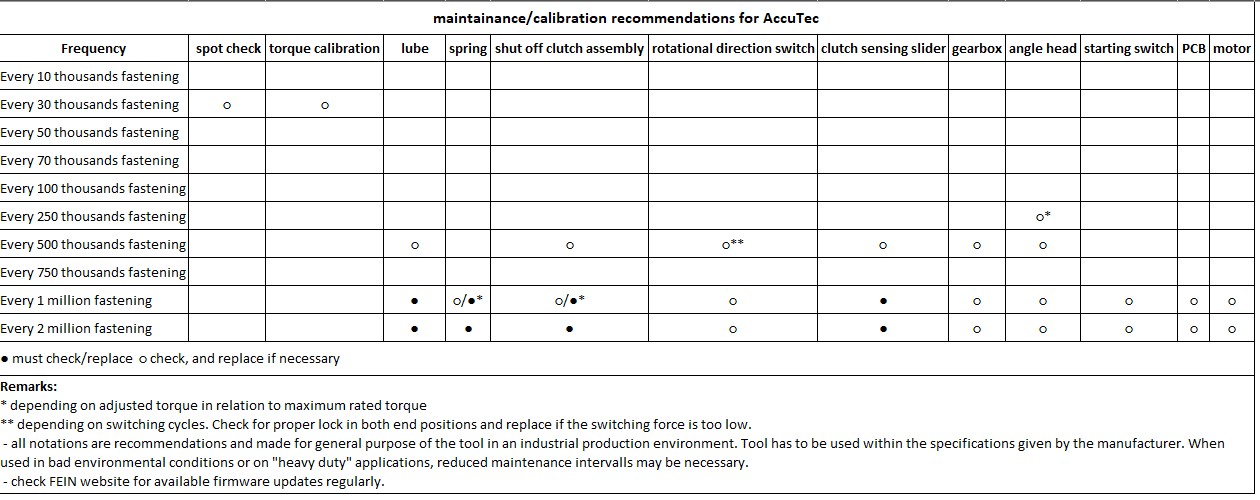
Are there any other core drill holding systems?
Question:
Are there any other core drill holding systems?
Answer:
Weldon 32, Weldon 1-1/4",
M18, Universal (WelNit, FullUniversal, One-Touch, Fusion II)
Can I resharpen / regrind my carbide or HSS core drills?
Question
Can I resharpen / regrind my carbide or HSS core drills?
Answer:
In principle, this is possible with carbide and HSS core drills.
However, a special grinding machine and the necessary rake and clearance angles are required.
There are special grinding companies that specialize in resharpening/regrinding.
As a rule, however, carbide and HSS core drills are not resharpened or reground. The costs for this are close to those of a new purchase.
Can I use Fein core drilling machines to machine HARDOX 400 and 450?
Frage:
Can I use Fein core drilling machines to machine HARDOX 400 and 450?
Antwort:
There are different HARDOX grades: 400, 450, 500, 550, and 600.
Please note that our tools can only be used to machine HARDOX grades 400 and 450.
The core bit life is approximately 0.25 m. This corresponds to approximately 20 holes with a HM Ultra, ø 18 mm, in HARDOX 400 with a material thickness of 12 mm.
For successful core drilling in HARDOX 400 and 450, the following points must be observed:
Please open PM application tips
Can a 60° bevelled edge with a length of 3-4 mm be applied to the inside and outside of a pipe using an edge milling machine?
Question:
Can a 60° bevelled edge with a length of 3-4 mm be applied to the inside and outside of a pipe using an edge milling machine?
Answer:
Basically, it will be very difficult to apply a 60° bevel on both sides, as you will no longer have any support for your machine guide.
You will have to tilt constantly. You will need to practice a lot to do this in exactly the same way.
Media:
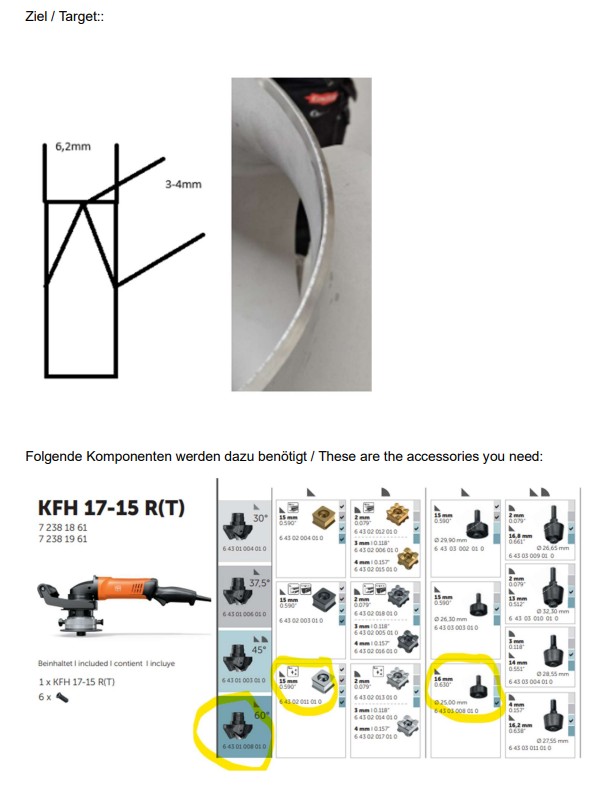
64301008010, Fräser, 64302011010, Wendeschneidplatte, 64303008010, Führungsrolle
Can aerated concrete also be processed with the MKAS 355?
Question:
Can aerated concrete also be processed with the MKAS 355?
Answer:
The MKAS 355 is not intended for sawing materials other than metal.
Sawing gas concrete also produces mineral dust, which is harmful to the motor.
The MKAS 355 cross-cut saw is not designed for this.
Can cast iron also be machined with the MKAS 355??
Question:
Can cast iron also be machined with the MKAS 355??
Answer:
Cast iron can be machined with the MKAS 355
We recommend the mild steel saw blade 63502302000
Can our shut-off wrenches (AccuTec) also be used for left-hand threaded connections?
Question:
Can our shut-off screwdrivers (AccuTec, ASM, ASW) also be used for left-hand threaded connections?
Answer:
AccuTec mechanical shut-off screwdrivers are designed for tightening right-hand threads (geometry coupling) and shut off with a repeat accuracy of +/- 5%.
Anything that is screwed tight can also be opened again with the reverse rotation (loosening torque higher than the tightening torque).
Mechanical shut-off is possible in reverse, but not with an accuracy of +/- 5% (the dispersion is higher – there is also no homologation test for this), and screw connections that have been made in reverse cannot be opened again with clockwise rotation.
We do not recommend FEIN AccuTec for continuous use for screw connections in reverse.
One option for left-hand screw connections (continuous use) is EC screwdrivers (different technology, not comparable with mechanical shut-off screwdrivers). These are programmable and can precisely control and monitor torque, speed, and angle of rotation. There are several suppliers on the market offering this technology.
If you are interested in testing FEIN AccuTec, please do not hesitate to contact us.
Core drills with 1 or 2-speed gearbox. Which is better?
Question:
Core drills with 1 or 2-speed gearbox. Which is better?
Answer:
If core drilling is only carried out in the diameter range of 12 - 35 mm, it is sufficient if the machine only has one mechanical speed. This is usually approx. 450 / 500 rpm (KBE 32 / KBE 32 QW) Some core drilling machines are also equipped with an electronic speed setting. Here it is possible to reduce the mechanical speed by up to 50%. However, it should be borne in mind that a slower speed also means less motor cooling through the fan wheel (KBU 35 Q / KBU 35 QW). 2nd gear machines are used in the diameter range from 12 - 65 mm. The two speed levels of approx. 250 / 500 rpm allow the speed to be adapted to the core drilling diameter and are also significantly more versatile in terms of the material to be drilled (KBM 50 Q, KBM 50 U, KBM 65 U / KBM 50 UQW, KBM 65 UQW)
Correct reading of RFID TAG on CG 15 angle grinder series
Situation/initial situation:
Incorrect RFID tag is read by angle grinders in the CG 15 series
Cause:
Due to the fact that both an RFID sticker (with ID) and electronics with an NFC module (with ID) are located in the angle grinder, it is possible that the TAG number of the NFC module may be accidentally read during the readout process. This TAG number cannot be used to identify the serial number, as it is not linked to the serial number in SAP. The NFC module is only used for parameterization.
With the start of the changeover on September 19, 2025
Order: 1000047292
Item number: 72250812360
First serial number: 2025-09-000061
RFID machine: E002590568976D65
A separate RFID tag will no longer be affixed to the upper shell of the motor housing.
Instead, only the RFID number stored in the NFC chip of the electronics will be used to identify the serial number.
Solution:
Until the changeover, the machine can only be identified using the TAG number (identifier) of the RFID chip that is affixed to it.
This TAG number does not correspond to the serial number of the machine.
Our technical support team (Service@fein.de) can convert the TAG number into the corresponding serial number of the machine.
The position of the RFID sticker can be seen in the images under Media.
NFC chips are manufacturer-specific coded, which can be identified by the first 4 digits of their code. For Fein, this means:
RFID chip for machine identification begins with E004...
NFC chip on the electronics (e.g., CG15) begins with E002...
Construction deviation request
Media:
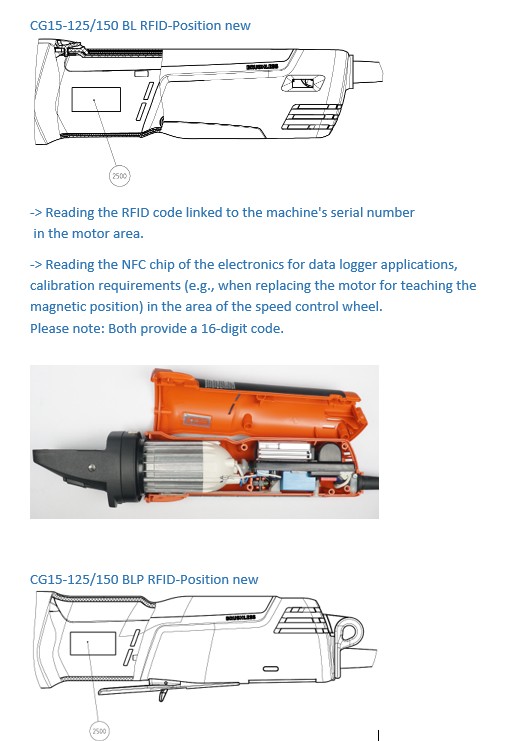
Dimensioned drawing KBC 36
Question:
Where can I find the dimension for the distance between the center of the core drill and the front edge of the gearbox, magnetic base.
Answer:
You can find the drawing with the dimensions click here
Do I need an adapter for my machine?
Question:
Do I need an adapter for my machine?
Answer:
Depending on the respective mounting system of the core drill or core bit, FEIN offers the appropriate adapters and centering pins for both machines/core drills with 3/4-inch Weldon or FEIN QuickIN to switch to the other system.
